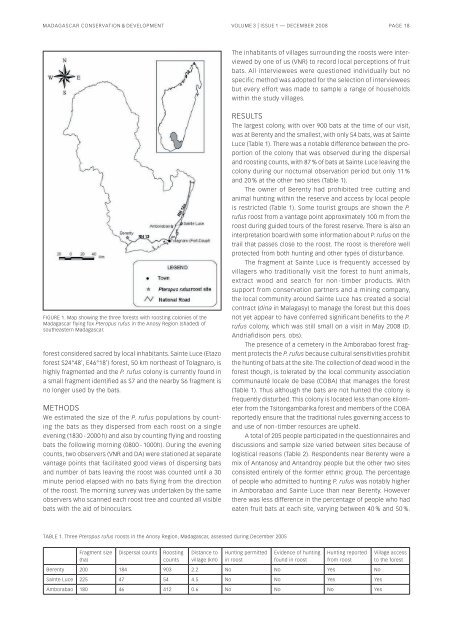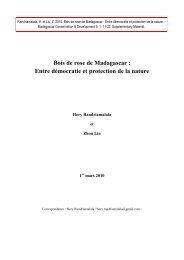Journal Madagascar Conservation - Madagascar Wildlife ...
Journal Madagascar Conservation - Madagascar Wildlife ...
Journal Madagascar Conservation - Madagascar Wildlife ...
You also want an ePaper? Increase the reach of your titles
YUMPU automatically turns print PDFs into web optimized ePapers that Google loves.
MADAGASCAR CONSERVATION & DEVELOPMENT VOLUME 3 | ISSUE 1 — DECEMBER 2008 PAGE 18<br />
FIGURE 1. Map showing the three forests with roosting colonies of the<br />
<strong>Madagascar</strong> flying fox Pteropus rufus in the Anosy Region (shaded) of<br />
southeastern <strong>Madagascar</strong>.<br />
forest considered sacred by local inhabitants. Sainte Luce (Etazo<br />
forest S24°48’, E46°18’) forest, 50 km northeast of Tolagnaro, is<br />
highly fragmented and the P. rufus colony is currently found in<br />
a small fragment identified as S7 and the nearby S6 fragment is<br />
no longer used by the bats.<br />
METHODS<br />
We estimated the size of the P. rufus populations by counting<br />
the bats as they dispersed from each roost on a single<br />
evening (1830 - 2000 h) and also by counting flying and roosting<br />
bats the following morning (0800 - 1000h). During the evening<br />
counts, two observers (VNR and DA) were stationed at separate<br />
vantage points that facilitated good views of dispersing bats<br />
and number of bats leaving the roost was counted until a 30<br />
minute period elapsed with no bats flying from the direction<br />
of the roost. The morning survey was undertaken by the same<br />
observers who scanned each roost tree and counted all visible<br />
bats with the aid of binoculars.<br />
TABLE 1. Three Pteropus rufus roosts in the Anosy Region, <strong>Madagascar</strong>, assessed during December 2005<br />
Fragment size<br />
(ha)<br />
Dispersal counts Roosting<br />
counts<br />
Distance to<br />
village (km)<br />
The inhabitants of villages surrounding the roosts were interviewed<br />
by one of us (VNR) to record local perceptions of fruit<br />
bats. All interviewees were questioned individually but no<br />
specific method was adopted for the selection of interviewees<br />
but every effort was made to sample a range of households<br />
within the study villages.<br />
RESULTS<br />
The largest colony, with over 900 bats at the time of our visit,<br />
was at Berenty and the smallest, with only 54 bats, was at Sainte<br />
Luce (Table 1). There was a notable difference between the proportion<br />
of the colony that was observed during the dispersal<br />
and roosting counts, with 87 % of bats at Sainte Luce leaving the<br />
colony during our nocturnal observation period but only 11 %<br />
and 20 % at the other two sites (Table 1).<br />
The owner of Berenty had prohibited tree cutting and<br />
animal hunting within the reserve and access by local people<br />
is restricted (Table 1). Some tourist groups are shown the P.<br />
rufus roost from a vantage point approximately 100 m from the<br />
roost during guided tours of the forest reserve. There is also an<br />
interpretation board with some information about P. rufus on the<br />
trail that passes close to the roost. The roost is therefore well<br />
protected from both hunting and other types of disturbance.<br />
The fragment at Sainte Luce is frequently accessed by<br />
villagers who traditionally visit the forest to hunt animals,<br />
extract wood and search for non - timber products. With<br />
support from conservation partners and a mining company,<br />
the local community around Sainte Luce has created a social<br />
contract (dina in Malagasy) to manage the forest but this does<br />
not yet appear to have conferred significant benefits to the P.<br />
rufus colony, which was still small on a visit in May 2008 (D.<br />
Andriafidison pers. obs).<br />
The presence of a cemetery in the Amborabao forest fragment<br />
protects the P. rufus because cultural sensitivities prohibit<br />
the hunting of bats at the site. The collection of dead wood in the<br />
forest though, is tolerated by the local community association<br />
communauté locale de base (COBA) that manages the forest<br />
(Table 1). Thus although the bats are not hunted the colony is<br />
frequently disturbed. This colony is located less than one kilometer<br />
from the Tsitongambarika forest and members of the COBA<br />
reportedly ensure that the traditional rules governing access to<br />
and use of non - timber resources are upheld.<br />
A total of 205 people participated in the questionnaires and<br />
discussions and sample size varied between sites because of<br />
logistical reasons (Table 2). Respondents near Berenty were a<br />
mix of Antanosy and Antandroy people but the other two sites<br />
consisted entirely of the former ethnic group. The percentage<br />
of people who admitted to hunting P. rufus was notably higher<br />
in Amborabao and Sainte Luce than near Berenty. However<br />
there was less difference in the percentage of people who had<br />
eaten fruit bats at each site, varying between 40 % and 50 %.<br />
Hunting permitted<br />
in roost<br />
Evidence of hunting<br />
found in roost<br />
Hunting reported<br />
from roost<br />
Berenty 200 184 903 2.2 No No Yes No<br />
Sainte Luce 225 47 54 4.5 No No Yes Yes<br />
Amborabao 180 46 412 0.6 No No No Yes<br />
Village access<br />
to the forest



